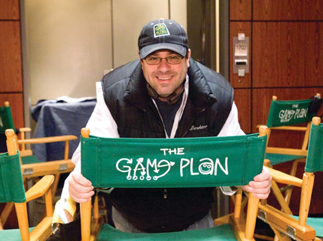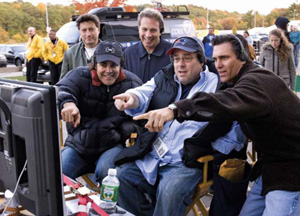BY ANDY FICKMAN
 Andy Fickman says nothing says "director" as much as the seat he occupies on the set.
Andy Fickman says nothing says "director" as much as the seat he occupies on the set.
Recently I was asked to speak to a class of college film students. I prepared for my session the night before by studying cinema via the Internet. First I brushed up on film criticism by reading top-flight film reviews written by angry, bitter 12 year olds. You are right, HotDawgz98, "black and white films that are old and in black and white do suck it." I then spent time on YouTube checking out a lot of short films— many of which I voted on—and I tended to give them all "6's," though in my heart I feared several were "7's." I also went to Wikipedia and read up on accurate Hollywood history. Jews. Who knew? Seriously, who knew? To end the evening, I Googled my name and read what people had to say about some of my past work. That was fun. I am never gonna do that again.
I arrived on campus feeling eager and prepared for any directorial question—unless it had to do with lenses or lighting or junk like that—which to me is better answered by a more knowledgeable studio exec.
Okay, time for the Q&A in which I would wow them with my directorial expertise. The first question was a total hardball: "Hi, I'm Stacy, a freshman. What is the difference between directing film, television, and theater?" So I take the hardball and run with it: "Great question, Stacy. The difference is clearly... uh... well... it's... uh... (Remember Albert Brooks' flop sweat in Broadcast News? Times that by 100). Stacy and her fellow students were starting to sense that I clearly had nothing to say... nada... zero answers... when all of a sudden it hit me.
The difference, I blurted out, was the director's chair! There, I said it... the great unspoken truth. Hollywood's dirty little secret is that it all comes down to... the director's chair. It's not called the actor's/gaffer's/transportation's chair. It's ours. It's the director's chair.
Nothing says "I am the most important person on the film set" more than a chair that says "director." It is our throne in the castle at the center of video village. Without it, how could we direct? More importantly, how would people know we were the director? Not just anyone can sit in your chair.
Imagine the panic you'd go through if you didn't see your chair set up. Where would you sit for the fifty-five minutes of the hour in which you just sit and wait and get anxious, gearing up for the five minutes of the hour you get to yell "Action" and/or "Cut." FYI: With HD you don't have to yell anything. You never even turn it off. Ever.
Imagine the turmoil you would go through if you saw a "guest" had dared to sit in your director's chair. How annoyed would you be? The gall. Granted she's the star's 92-year-old grandmother, but the chair says "director," not "frail old lady." I always rush up and with great force say to anyone sitting in my director's chair, "Uh... please, stay seated, I'm good." This "standing" period officially counts as "exercise," which you can tell the film doctor when doing your film medical exam. It's box number 4.
The director's chair on a film set says loudly to all assembled, "There is a leader here who sits upon this chair. All questions about wardrobe, hair, makeup, lenses, turnaround, script changes, lunch menu, and budget overages should be directed to the person occupying the chair marked 'director.'" Unless it's the star's granny.
 Fickman (center) leads his team in front of video village-exactly where he should be.
Fickman (center) leads his team in front of video village-exactly where he should be.
The best director's chairs have not one but two side pockets. One is for your script, storyboards, notes—anything that says "I am a director," and if I put my hand in this pocket I will pull out something that says "director." The other side pocket is for beverages, food, old newspapers, salads, medication, chocolates, used Kleenex, loose mints, half-eaten sandwiches, and gravy. You should never stick your hand in this side pocket—it's full of bacteria, plus it's gross.
On a film set, the placement of your director's chair is crucial. It should be directly in front of video village. If your chair is behind the producers' chairs at video village, you should beware; they do not think you are the director. Sometimes your chair gets moved by "others" at video village. When that happens, to show who is boss, stand up in front of the monitors and block everyone's view. This is especially doable when filming outdoors and the courtesy viewing hole on the monitors can be blocked by shoving your entire head into it.
Recently, I saw a director's chair that was pimped out: Padded seat, cup holders, and a swivel desk. It was the Rolls-Royce of director's chairs. To afford it you must cut two days of filming from your schedule. It's Swiss-engineered, and everyone knows these people are the best in the world. They created IKEA and knives and blondes. You want this chair. Trust me.
A film set without a director's chair is anarchy. And whom do we have to thank for giving us this hot seat? The Telescope Cot Bed & Novelty Company, established in 1903. But it wasn't until 1953 when the company patented the current design we all know and love. Wikipedia, which is never wrong, claims that director's chairs date back to the 15th century coffer-makers and Roman curule chairs. These are words I don't understand, but I do understand that these chairs can hold a lot of weight without breaking. A lot.
As for how the chair differs in various mediums: in TV, unless it's your series, you'll never get one personalized with your name, and it's too obnoxious to bring one from home. Besides, in TV, with 800 producers, studio and network execs helping you direct, your chair is not all that special, maybe not even at video village. Last time I did TV, my director's chair was with the hair and makeup departments' low backs. Those are the short camping chairs that make their area resemble a Grateful Dead concert. Though in retrospect, there were less notes for me when my chair was in that section.
Imparting this insider information made me feel like Deep Throat, and the students were clearly impressed. They couldn't get enough. But I had one more morsel for them. As for theater, I told them, there are 1,800 chairs in the house to choose from. Sit your ass down in any one of them. You might just find you can still direct.